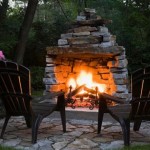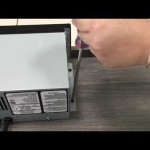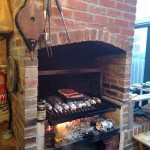Understanding Fireplace Parts Terminology
Fireplaces, historically a central feature of homes for heating and ambiance, are complex systems comprising various parts. Understanding the terminology associated with these parts is crucial for proper maintenance, repair, and safe operation. This article outlines the definitions and functions of essential fireplace components, categorized for clarity.
Exterior Fireplace Structure and Surroundings
The exterior components of a fireplace define its aesthetic appearance and interact with the room it occupies. These parts are often visible and contribute significantly to the fireplace's overall design.
Fireplace Mantel: The mantel is a decorative shelf or structure above the fireplace opening. Traditionally made of wood, stone, or brick, mantels serve both aesthetic and functional purposes. They provide a space for displaying decorative items and can offer some protection from heat exposure above the firebox.
Fireplace Surround: The surround refers to the non-combustible material that frames the fireplace opening. It typically consists of materials like tile, stone, brick, or metal, and serves to protect the surrounding wall from heat damage. The surround often complements the mantel in terms of design and material.
Hearth: The hearth is the non-combustible area in front of the fireplace opening. Its primary purpose is to protect the flooring from sparks, embers, and hot ashes that may escape the firebox. Hearths are commonly constructed from brick, stone, tile, or concrete.
Firebox: The firebox is the chamber where the fire is built. Constructed of fire-resistant materials like firebrick, the firebox withstands the high temperatures generated during combustion. It is the core of the fireplace where the burning process takes place.
Facing: Facing refers to the visible exterior surface of the fireplace structure. This can include the materials used for the surround, the area above the mantel, and any exposed brick or stone on the chimney breast. The facing significantly contributes to the fireplace's overall aesthetic appeal.
Essential Internal Components
The internal components are critical for the safe and efficient operation of the fireplace. These parts manage combustion, control airflow, and ensure that smoke and gases are properly exhausted.
Firebrick: Firebrick is a heat-resistant brick lining the firebox. Its specific composition allows it to withstand extremely high temperatures without cracking or deteriorating. Firebrick protects the surrounding structure from the intense heat of the fire.
Damper: The damper is a movable plate located within the chimney flue. It controls the airflow through the chimney. When the fireplace is in use, the damper should be open to allow smoke and gases to escape. When the fireplace is not in use, the damper should be closed to prevent drafts and heat loss from the house.
Smoke Shelf: The smoke shelf is a horizontal projection located behind the damper. It is designed to deflect downdrafts and prevent them from entering the firebox. The smoke shelf helps to maintain a consistent upward draft through the chimney.
Smoke Chamber: The smoke chamber is the area above the smoke shelf that narrows to connect to the chimney flue. Its purpose is to collect and compress the smoke and gases before they enter the chimney. A properly designed smoke chamber contributes to efficient draft and prevents smoke from spilling into the room.
Throat: The throat is the opening between the firebox and the smoke chamber. Its design is crucial for efficient smoke removal. A properly sized and shaped throat ensures that smoke is directed into the smoke chamber and up the chimney.
Grate: A grate is a metal framework within the firebox that supports the firewood. It allows air to circulate around the wood, promoting more efficient combustion. Grates are typically made of cast iron or steel.
Chimney and Ventilation System
The chimney is the vertical structure that carries smoke and gases away from the fireplace and releases them into the atmosphere. Its design and maintenance are crucial for safety and proper function.
Chimney Flue: The flue is the passageway within the chimney that carries smoke and gases. It can be constructed from various materials, including clay tiles, metal liners, or poured concrete. The flue must be properly sized to ensure adequate draft and prevent the buildup of creosote.
Chimney Cap: The chimney cap is a protective covering placed at the top of the chimney. It prevents rain, snow, leaves, and animals from entering the chimney. A chimney cap also helps to prevent downdrafts and improve the chimney's draft.
Chimney Liner: A chimney liner is a protective barrier installed inside the chimney flue. It serves to contain the combustion gases and prevent them from corroding the chimney structure. Liners are often made of stainless steel, clay, or cast-in-place materials.
Creosote: Creosote is a flammable deposit that accumulates inside the chimney flue as a byproduct of burning wood. It is a significant fire hazard and must be regularly removed through chimney sweeping. The buildup rate of creosote depends on factors such as the type of wood burned, the air supply, and the chimney's design.
Spark Arrester: A spark arrester is a mesh screen installed within the chimney cap. Its purpose is to prevent sparks and embers from escaping the chimney and potentially causing a fire on the roof or nearby vegetation. Spark arresters are required in many areas, particularly those with dry climates and a high risk of wildfires.
Gas Fireplace Specific Components
Gas fireplaces operate using natural gas or propane and incorporate specific components not found in traditional wood-burning fireplaces.
Gas Logs: Gas logs are ceramic or refractory logs designed to resemble real wood. They are placed within the firebox of a gas fireplace and provide a realistic flame appearance. Gas logs do not burn but are heated by the gas flame.
Gas Burner: The gas burner is the device that mixes gas and air to create a flame. It is typically located beneath the gas logs and is connected to a gas supply line. The burner is designed to distribute the gas evenly to create a consistent and aesthetically pleasing flame pattern.
Pilot Light: The pilot light is a small flame that continuously burns and ignites the main gas burner when the fireplace is turned on. Some gas fireplaces use electronic ignition systems instead of a pilot light.
Thermocouple: The thermocouple is a safety device that monitors the pilot light. If the pilot light goes out, the thermocouple shuts off the gas supply to prevent gas from leaking into the room. This is a crucial safety feature that prevents gas explosions.
Gas Valve: The gas valve controls the flow of gas to the burner. It is typically operated by a switch or remote control. The gas valve allows the user to turn the fireplace on and off and to adjust the flame height.
Tools and Accessories
Various tools and accessories are used to maintain and operate a fireplace safely and efficiently.
Fireplace Tools: Fireplace tools are a set of implements used to tend to a fire. These typically include a poker, shovel, tongs, and broom. The poker is used to rearrange the logs, the shovel is used to remove ashes, the tongs are used to move burning logs, and the broom is used to sweep the hearth.
Fire Screen: A fire screen is a metal mesh barrier placed in front of the fireplace opening. It prevents sparks and embers from escaping the firebox and potentially causing a fire or injury. Fire screens are available in various styles and designs to complement the fireplace's aesthetic.
Ash Bucket: An ash bucket is a metal container used to safely collect and dispose of ashes from the fireplace. It is important to use a metal bucket with a tight-fitting lid to prevent the ashes from spreading and potentially causing a fire.
Firewood Rack: A firewood rack is a storage structure used to keep firewood dry and organized. It elevates the wood off the ground, allowing air to circulate and prevent rot. Firewood racks are available in various sizes and designs to accommodate different amounts of wood.
Bellows: Bellows are a tool used to provide a burst of air to rekindle a dying fire or to encourage a stubborn ember to ignite. They consist of a flexible chamber with a nozzle that directs the air flow.
Understanding these terms is essential for anyone involved in the maintenance, repair, or installation of fireplaces. Proper knowledge of these components contributes to safe and efficient fireplace operation.

What Are The Components Of A Fireplace Five Ways Fires

Fireplace Terms Shiplap Feature Wall Mantel Surrounds Remodel

Fireplace Terms
Deciphering Common Fireplace Terms

Fireplace Anatomy Wilkens Contracting Masonry Toronto

Blog Www Cedesign Com Shiplap Feature Wall Fireplace Mantel Surrounds Remodel

Anatomy Of A Fireplace Mantel Is Not Always Just Paloform Parts Design Concrete

Dulley Column Anatomy Of A Fireplace

The 10 Hottest Instagram Fireplace Ideas In 2024 Newhomesource

The Ultimate Buyer S Guide To Fireplace Terminology R T Services
Related Posts








